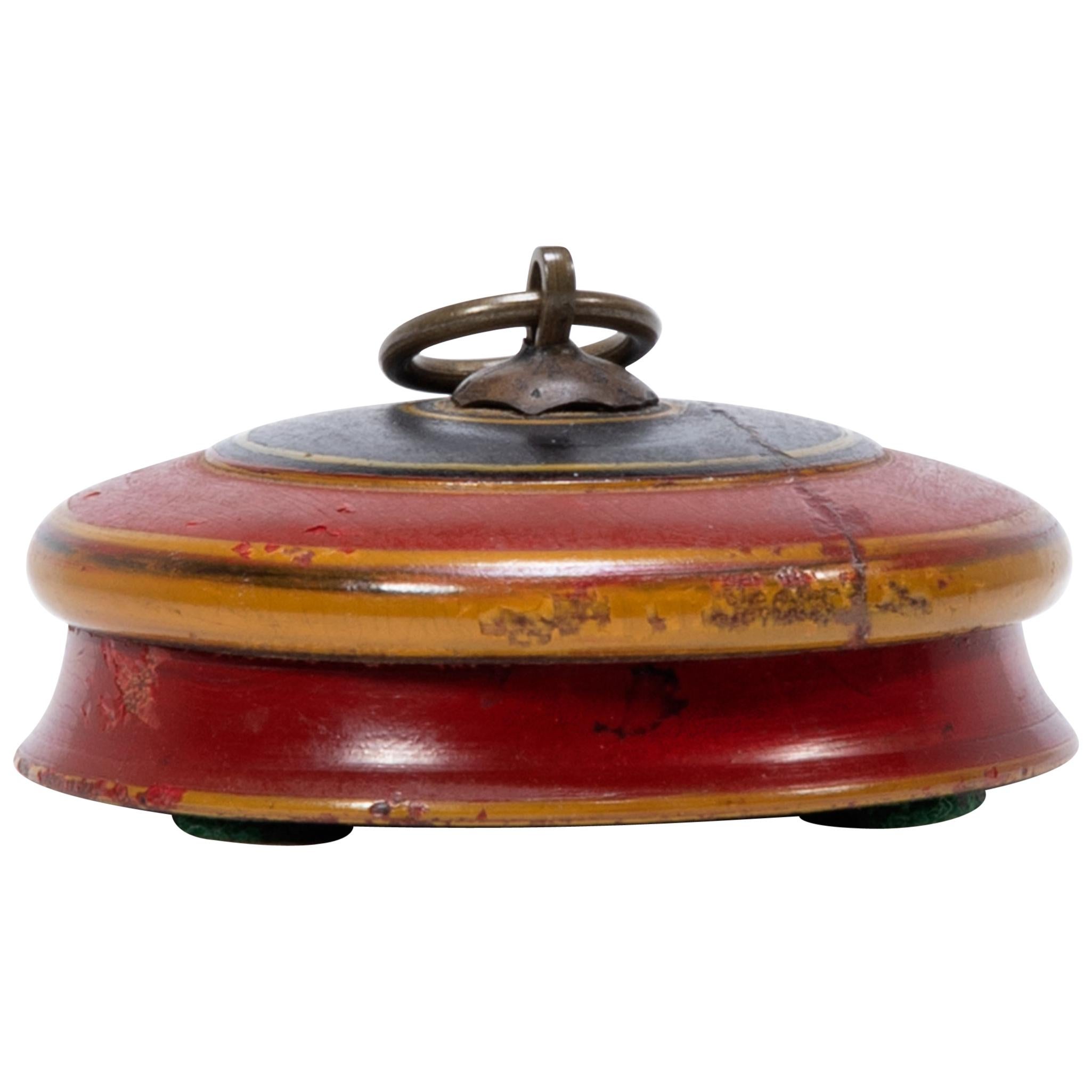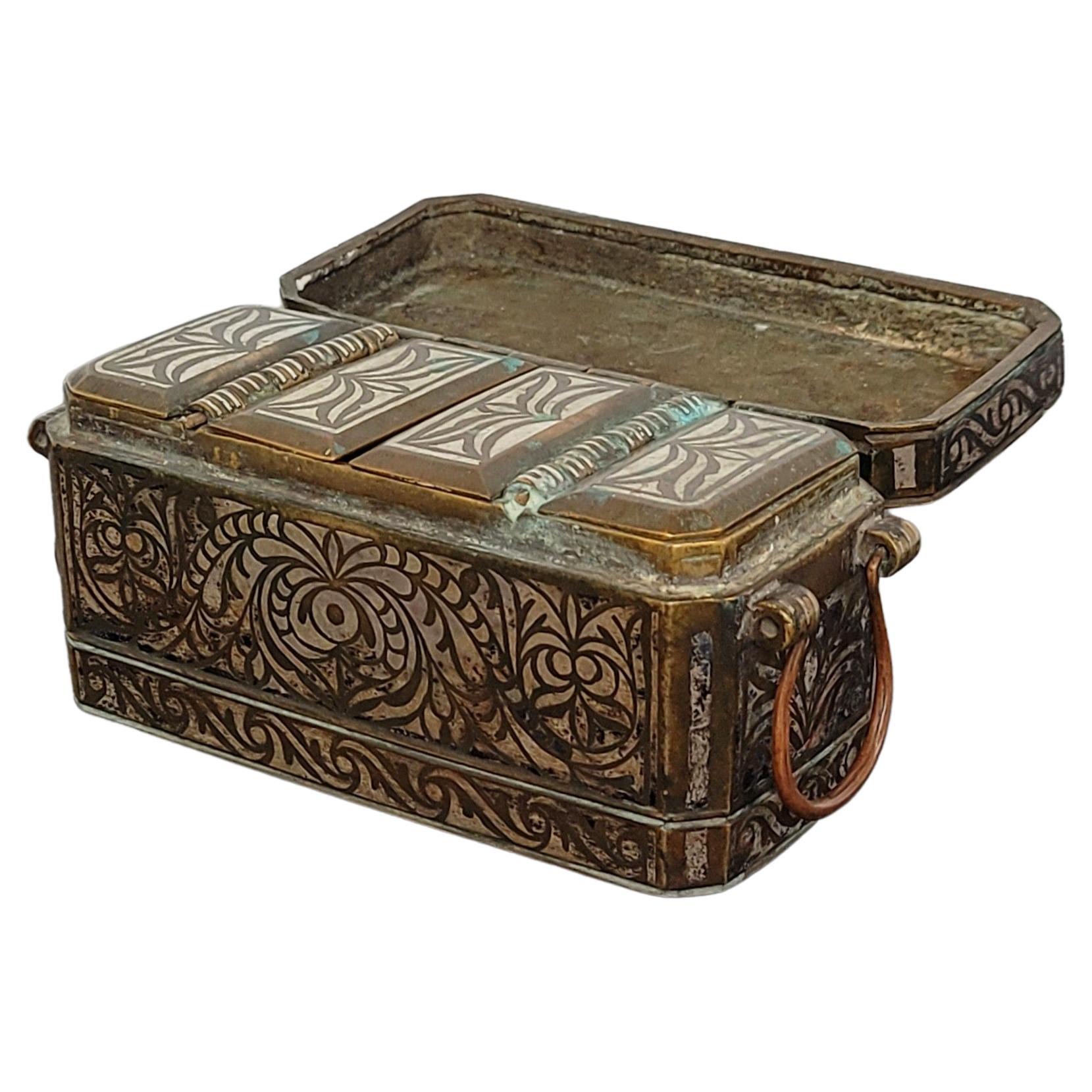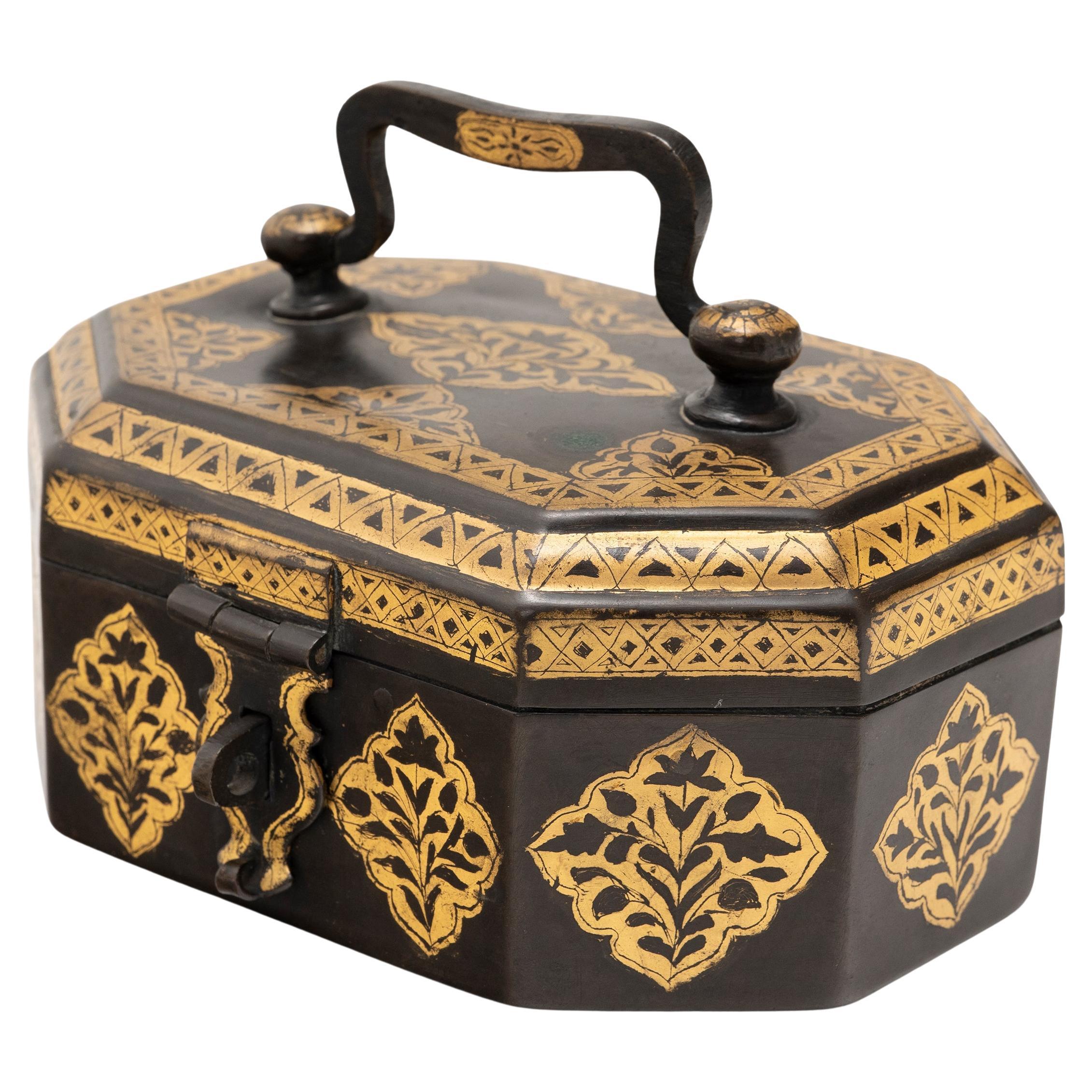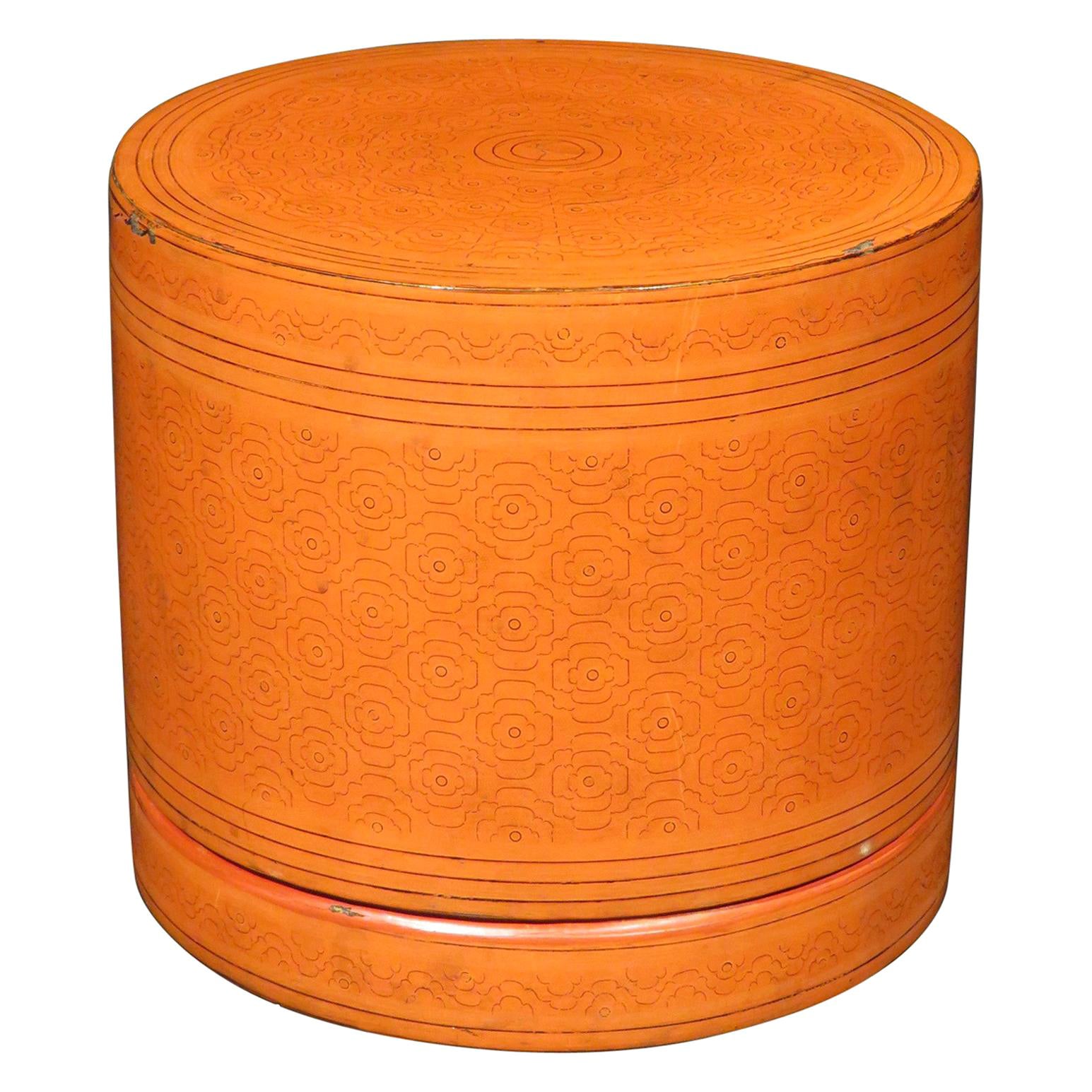Items Similar to Southeast Asian Red Lacquer Betel Box, c. 1900
Want more images or videos?
Request additional images or videos from the seller
1 of 6
Southeast Asian Red Lacquer Betel Box, c. 1900
About the Item
In many southeast Asian cultures, offering guests a betel quid to chew was the fundamental symbol of hospitality. A blend of leaves, nuts, seasonings, and sometimes tobacco, betel was kept in finely worked and decorated boxes. This round betel box is painted with concentric circles of red and black lacquer, delineated by finely etched lines that were likely once filled with gold pigment. Still vibrant after a century of use, the petite box is wonderful as simple way to store jewelry or other precious smalls.
- Dimensions:Height: 3 in (7.62 cm)Diameter: 4 in (10.16 cm)
- Materials and Techniques:Wood,Lacquered
- Place of Origin:
- Period:
- Date of Manufacture:circa 1900
- Condition:Wear consistent with age and use.
- Seller Location:Chicago, IL
- Reference Number:

About the Seller
4.9
PAGODA RED is a renowned resource for designers as well as collectors of contemporary and ancient Chinese, Korean and Japanese art. They offer a curated edit of fine and provincial furniture, ceramics, scholars' objects, and paintings and textiles, each piece historically and geographically authentic.
Diamond Seller
These expertly vetted sellers are 1stDibs' most experienced sellers and are rated highest by our customers.
Established in 1997
1stDibs seller since 2006
1,415 sales on 1stDibs
Typical response time: 1 hour
- ShippingRetrieving quote...Ships From: Chicago, IL
- Return PolicyA return for this item may be initiated within 2 days of delivery.
More From This SellerView All
- Red Lacquer Betel Box, c. 1900Located in Chicago, ILIn many southeast Asian cultures, offering guests a betel quid to chew was the fundamental symbol of hospitality. A blend of leaves, nuts, seasonings, and sometimes tobacco, betel was kept in finely worked and decorated boxes. This round betel box...Category
Early 20th Century Southeast Asian Decorative Boxes
MaterialsWood
- Indian Brass Betel Nut Box, c. 1900Located in Chicago, ILThis ornate Indian betel nut box dates back to the early 20th century. Known in India as a paan daan, this box was used in the ritual of chewing betel nut or paan, a practice that da...Category
Early 20th Century Indian Folk Art Decorative Boxes
MaterialsBrass, Copper
- Chinese Gilt Lacquer Hat Box, c. 1900Located in Chicago, ILNo self-respecting man in Qing-dynasty China would leave the house without some kind of hat. In fact, headgear was so central to social status that even the containers used to store ...Category
Antique Late 19th Century Chinese Qing Decorative Boxes
MaterialsHide, Fabric, Wood
- Chinese Gilt Black Lacquer Carrying Box, c. 1900Located in Chicago, ILThis early 20th century painted box was originally used as a portable traveling container, especially used for meals, snacks, and food offerings. The wooden box is crafted with eight sides, a lucky number believed to bring prosperity. Brushed atop layers of red and black lacquer, gilt linework decorates the sides with scrollwork, ruyi, and chrysanthemums, symbols of autumn and longevity. The lid is painted with a young boy carrying a lantern, conveying a blessing of abundance. Dense with symbolism, this painted carrying box...Category
Early 20th Century Chinese Qing Decorative Boxes
MaterialsWood
- Chinese Black Lacquer Presentation Box, circa 1900Located in Chicago, ILThis simple lacquered box is a 19th century snack box, presented as a gift during holidays and special occasions. To the delight of the recipients, the unassuming box would have open...Category
Early 20th Century Chinese Qing Decorative Boxes
MaterialsPine
- Chinese Double Happiness Lacquered Snack Box, c. 1900Located in Chicago, ILThis simple lacquered container was once a portable snack box, presented as a gift during holidays and special occasions. To the delight of the recipients, the unassuming box would h...Category
Early 20th Century Chinese Qing Lacquer
MaterialsWood, Lacquer
You May Also Like
- Antique Southeast Asian Filipino Maranao Silver Inlaid Brass Betel Nut BoxLocated in Forney, TXA scarce fine quality antique silver-inlaid solid brass betel nut box (Lutuan), dating to the second half of the 19th / early 20th century, hand-crafted in Mindanao, Philippines. Boxes such as this were used to store the areca nut (also known as the betel nut) which would be wrapped in a betel leaf with lime paste and other ingredients, often tobacco, for chewing. Similar to the European tea caddy, these boxes often served as a way to impress while showing off ones wealth. Betel chewing was prevalent in the southern Philippines as in much of the rest of Southeast Asia. Wealthier Maranao families on Mindanao were able to afford elaborate silver-inlaid brass betel boxes such as this example. Such boxes were used to show off to guests and from which they were offered betel and the other component such as leaves and lime to make up the betel quid. Rare large size, most extant examples of such boxes tend to measure around 5 inches in length. At slightly more than 7.75 inches the example here is larger than most. The distinctive decorative box features a very heavy strong-box like rectangular shaped chest form with canted corners, copper handles, and a conforming hinged lid, lifting open to reveal an interior divided into three compartments covered by four hinged lids. Each of these doors is inlaid with silver in stylized orchid flower patterns. Exceptionally executed throughout, the arabesque silver inlaid exterior is decorated to the top with a large orchid motif within scrolling obid-obid (stylized rope) borders. The front, back and sides are inlaid with sets of stylized tail feathers of the sari-manok bird beneath which are unusual, highly stylized whimsical zoomorphic faces that appear like cat or tiger faces. (Such stylisation is accounted for by Southeast Asian Islamic preferences to avoid the overt and this potentially idolatrous representation of animal and human forms. Designs such as these are drawn from a local design repertoire that has its origins in wood carving. Although the spread of Islam in the Philippines began in the 14th century, mostly through the influence of Muslim merchants from the western Malay Archipelago, decorative arts in this design remain exceptionally rare. This lutuan represents a fine example of Islamic metalwork from the most eastern outreach of Islamic art and civilisation: Mindanao island being significantly further east than even China – artwork from Islamic Southeast Asia remains chronically under-represented in the world’s major collections of Islamic art. PROVENANCE / ACQUISITION Acquired from highly reputable auction house, Austin Auction Gallery, established 1983, Austin, Texas. References Brownrigg, H., Betel Cutters...Category
Antique 19th Century Philippine Islamic Decorative Boxes
MaterialsSilver, Brass, Bronze, Copper
- Highly Decorative Antique Burmese Lacquered Betel Box / Kun-It, Circa 1900Located in Ottawa, OntarioThe vermillion lacquered cylindrical body decorated overall with repeating bands of curvilinear geometric motifs, the cover lifting to reveal both of its original trays intended to h...Category
Early 20th Century Burmese Lacquer
MaterialsLacquer, Bamboo
- Southeast Asian Silver Repousse Pumpkin Shaped BoxLocated in Guaynabo, PRThis is a Southeast Asian silver metal pumpkin shaped box. The ribbed areas of the silver pumpkin box is decorated with the relief of scrolls of aca...Category
20th Century Cambodian Arts and Crafts Decorative Boxes
MaterialsSilver
- Asian Handcrafted Oval Betel Box in Metal SilveredLocated in North Hollywood, CAAsian decorative trinket lidded box in metal silvered hammered and etched with organic floral design. Anglo Raj style oval form betel box. Dimensio...Category
Mid-20th Century Indian Anglo Raj Metalwork
MaterialsMetal
- Burmese Lacquerware Betel BoxLocated in New York, NYBurmese antique lacquerware betel box. Individual Betel Box authentic Burmese Folk Art know as Kun- It, Mandalay Period. A lacquered cylindrical body of woven turned Bamboo decorated by incised lacquer overall with Chu-pan variant motif and traditional Folk Art characters. This Betel Box has four bowls that make up the entire box. This is a complete Burmese Lacquerware Betel Box. Each bowl has a purpose. The top and base work as large containers and two shallow dishes work as small bowls. The workmanship is very unique having exquisite height details to the bottom of the base container and the two shallow bowls showcasing a complex design to the weaving. Antique Burmese Lacquerware is highly collectible, having books written on this Folk Art with museums having collections and exhibits of same. A very nice antique Burmese Betel Box...Category
Early 20th Century Burmese Other Decorative Boxes
MaterialsLacquer
- Japanese Lacquer Box, 1900Located in Marseille, FRJapanese lacquer box 1900 decorated with sparrows, gold lacquer on a black background of very good quality, good general condition. The dimensio...Category
Antique 19th Century Decorative Boxes
MaterialsLacquer
Recently Viewed
View AllMore Ways To Browse
Antique Lacquerware
Showa Era
Chinese Fan Antique
Antique Chinese Fan
Chinese Antique Fan
Antique Chinese Fans
Chinese Export Jade
Chinese 1900 1920
Asian Bone China
Wabisabi Art
Taisho Era
Japanese Woven Bamboo
Japan Made Figurines
Bat Chinese
Japanese Antique Board
Vintage Japanese Wooden Furniture
Chinese Jade Flower
Chinese Hand Fan





